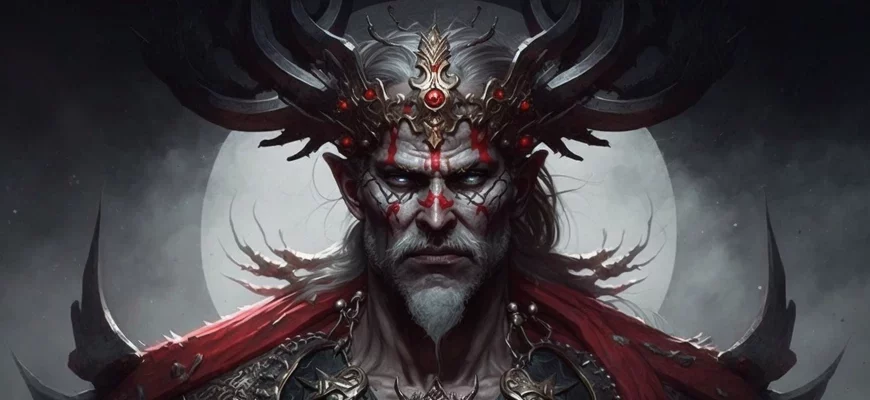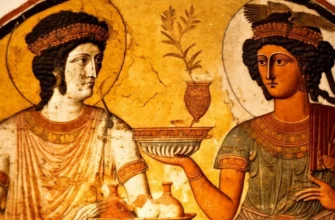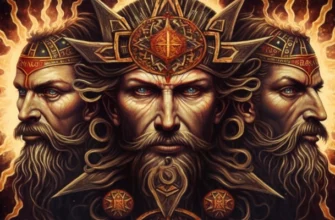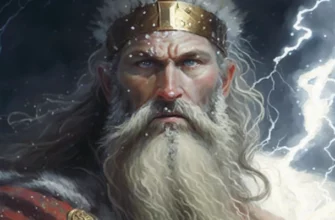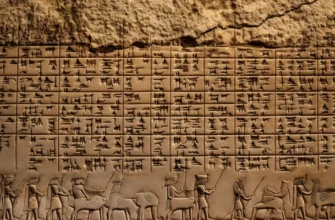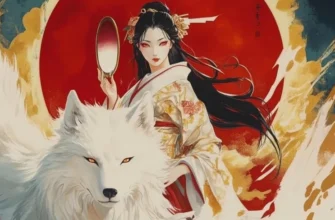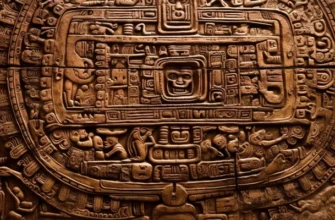Chornobog is a Slavic god who played an important role in the lives of Slavic peoples. His name comes from the Slavic words “black” and “god,” indicating his connection with darkness, evil, and death.
Chornobog is usually depicted as a man in black clothing, sometimes with animal features, such as a goat or a wolf. In Slavic mythology, he was the opposite of the Holy God, the embodiment of good and light.
Beliefs about Chornobog varied among different Slavic cultures, but in general, he was considered the god of darkness, magic, and the underworld. In modern Slavic culture, Chornobog is interpreted in different ways, but he is often associated with neo-paganism and other spiritual movements.
In the later period of Slavic history, the Christian church gradually supplanted the ancient deities, including Chornobog, but his name and image remain important parts of Slavic mythology.
Who is Chornobog?
Chornobog is the god of darkness, evil, and death in Slavic mythology. His name comes from the Slavic words “black” and “god,” indicating his connection to darkness and gloom.
In Slavic mythology, Chornobog was usually seen as the opposite of the Holy God, who represents light and goodness. His name can be found in various Slavic cultures and has different shades of meaning depending on the context.
Chornobog is usually depicted as a man in black clothing, sometimes with animal features, such as a goat or a wolf. In Slavic mythology, he was often associated with magic and the underworld.
In modern Slavic culture, Chornobog is interpreted in different ways. His image can be used in literature, art, and other forms of culture as a symbol of darkness and evil. At the same time, he is also associated with neo-paganism and other spiritual movements that seek to revive Slavic mythology.
In the later period of Slavic history, the Christian church gradually supplanted the ancient deities, including Chornobog. However, his name and image remain important parts of Slavic mythology and culture.
Historical information about the god Chornobog
The god Chornobog (black god) is one of the pantheon of gods in Slavic mythology, personifying darkness and evil. He was the opposite of light and good, which was perceived as the sun and the god Svarog.
In ancient times, the Slavs perceived the world as an interactive system of opposites, an idea that can be traced in the beliefs about the god Chornobog. According to legend, Chornobog lived in the dark and cold depths of the earth, where night and poverty reigned.
Information about Chornobog was recorded in written sources dating back to the 11th century. However, more details about this god can be found in references in folklore works such as “The Tale of Igor’s Campaign” and “The Tale of Panteleimon.”
In medieval Rus, Chornobog was often associated with black magic, witchcraft, and darkness. This was due to the fact that some people used this belief for their own purposes and power.
Over time, belief in the god Chornobog gradually disappeared, and he became a symbol of darkness and evil in folk culture. However, some historical research indicates that he may be associated with the ancient cult of the first nomadic Scythians.
The role of Chornobog in Slavic mythology
The role of the god Chornobog in Slavic mythology was to personify darkness and evil. His presence in the pantheon of gods emphasized the idea of the interaction of opposites, where the presence of light and good requires the presence of darkness and evil.
In ancient times, the Slavs believed that Chornobog lived in the cold and dark depths of the earth, from where he exercised his influential power over darkness and evil. According to legend, in some cases, Chornobog was put on guard against the sun and the interference of the gods Svarog and Perun.
Chornobog was also of great importance to Slavic folk culture and folklore. In many stories and tales, Chornobog was portrayed as an evil god who tries to hinder people and destroy light and goodness.
In the Middle Ages, the god Chornobog was often associated with black magic and witchcraft. This was due to the abuse of his name for personal gain and power.
Over time, belief in the god Chornobog disappeared, but he remained an important symbol of darkness and evil in Slavic culture and folklore. Due to his significance, Chernobog is one of the most famous and important gods in Slavic mythology.
Belief in Chernobog in different Slavic cultures
Belief in Chernobog was widespread among different Slavic cultures, although he may have different names depending on the region.
For example, among Western Slavs, such as Poles and Czechs, Chernobog was called Czarny Pan (Black Lord in Polish, černý pán in Czech) and was depicted as an evil god who controlled darkness and was responsible for evil.
Among the southern Slavs, such as the Serbs, Croats, and Slovenes, Chernobog was called Crnobog (in Serbian and Croatian, Črni bog in Slovenian) and was depicted as an evil god who brought misfortune and darkness.
Among the Eastern Slavs, such as the Ukrainians and Russians, Chernobog was called Chorny Yar (Чорний Яр in Ukrainian, Черный Яр in Russian) and was also depicted as an evil god who was responsible for darkness and evil.
Belief in Chornobog reflected the Slavs’ attitude toward darkness and evil, and he was usually perceived as the opposite of the god of light and good. Although belief in Chornobog is a thing of the past, he remains an important symbol in Slavic culture and art, and his image can be found in modern pop culture and fantasy literature.
Modern interpretation of the god Chornobog
The god Chornobog belongs to the pantheon of Slavic gods and is one of the most mysterious deities in this mythology. In ancient times, Chornobog was considered the god of darkness, chaos, failure, evil, and death. However, the modern interpretation of Chornobog can vary.
Some people, especially those who value ancient Slavic traditions and culture, may perceive Chornobog as a symbol of vitality and transformation. They may see him as the god of new beginnings, who turns darkness into light and destroys the old to make way for the new.
Others may perceive Chornobog as a symbol of resistance to evil and the fight against it. They may believe that Chornobog is on the side of good and helps people overcome the darkness in their lives.
There are also people who may consider Chornobog to be simply a mythical character with no real meaning. They may believe that the concept of Chornobog is just a figment of the imagination of the ancient Slavs and has no meaning in our time.
In any case, the modern interpretation of Chornobog can vary and depend on the views of the people who perceive him.
Chornobog in modern Slavic culture
Chornobog as a deity is part of Slavic mythology, so his image and interpretation can be found in modern Slavic culture.
In some Slavic countries, such as Ukraine and Russia, various rituals and holidays associated with Chornobog are widespread. For example, in Ukraine, there is a ritual called “Chornobog,” when grain crops are sown on black soil during sowing to obtain a fertile harvest.
Chornobog may also appear in modern Slavic literature, art, and films. For example, in the novel “Chornobog” by writer Lesya Ukrainka, the deity is used as a symbol of darkness and evil, and in the film “The Witch” by director Vladimir Balabanov, Chornobog acts as the strongest guardian spirit.
In addition, Chornobog can be used in modern Slavic culture as a symbol of the color black, which can indicate negative emotions, mysticism, mystery, or darkness.
In general, the modern interpretation and use of the image of Chornobog in Slavic culture can be diverse and depend on the views and traditions of different people and groups.
Conclusion
Chornobog, a Slavic god, is one of the most famous and mysterious deities in Slavic mythology. His name literally means “black god,” which may indicate his role in death and destruction. However, there are also other interpretations of Chornobog’s significance in Slavic culture.
According to one version, Chornobog was a deity of the earth and harvest who controlled the fertility of the land and cared for the richness of vegetation. Others believe that he was the god of night and darkness, who possessed magical powers that compelled people to observe rituals and ceremonies.
In some myths, Chornobog is depicted as the brother of Svarog, the deity of the sun and light. In this version, Chornobog was responsible for night and darkness, while Svarog was responsible for day and light.
Chornobog is usually depicted as a black man with dark hair and a beard, and he may have wings or horns on his head. He is often associated with shadows, night, winter, and cold.
All these versions and images of Chornobog portray him as a powerful god with mysterious and enigmatic powers who played an important role in Slavic mythology and culture. His image is often used in literature, art, and the film industry, and he remains an inexhaustible source of interest for many people to this day.
